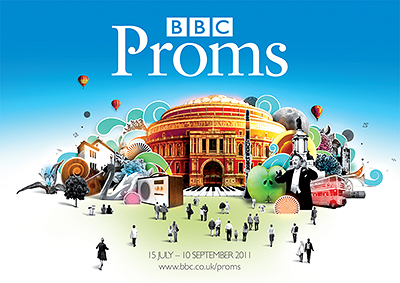 Simon Holt has been featured at the Proms on numerous occasions over the years, and yesterday his music returned to the Albert Hall with the orchestral work Centauromachy. It was given by the BBC National Orchestra of Wales, with whom Holt is Composer in Association; they were conducted by François-Xavier Roth, who also oversaw the première of the piece in November last year. The work features a pair of soloists, of distinct but not dissimilar timbres: clarinet in A and flugelhorn, played by Robert Plane and Philippe Schartz respectively.
Simon Holt has been featured at the Proms on numerous occasions over the years, and yesterday his music returned to the Albert Hall with the orchestral work Centauromachy. It was given by the BBC National Orchestra of Wales, with whom Holt is Composer in Association; they were conducted by François-Xavier Roth, who also oversaw the première of the piece in November last year. The work features a pair of soloists, of distinct but not dissimilar timbres: clarinet in A and flugelhorn, played by Robert Plane and Philippe Schartz respectively.
Holt has structured the work in five movements, the shortest of which comes first, featuring the soloists alone. Titled ‘Two natures’, it serves to compare and contrast the clarinet and flugelhorn, which at first take it in turns to attempt to catch each other, scurrying around, imitating, their phrases ending together on a unison note. It’s not until the third and final phrase that they move beyond a relatively narrow pitch space, moving swiftly to occupy distinct registral areas, the clarinet initially high above the flugelhorn, then leaping below it. Following a final chirrup, the second movement, ‘Chiron’s dream’ introduces the orchestra, rapidly materialising like a grand, cinematic fade-in. When the soloists restart their activity, it’s with forceful gestures, but they quickly yield to lines that continue to cling together. A trumpet strikes up a rapport with the flugel, while the strings seek to try something out in their uppermost register, delineated by glockenspiel strikes. Everything coalesces onto a lower note, from which the soloists again recommence strongly but immediately become soft; as earlier, though, Holt keeps the material restless, suggesting a dream that’s not entirely comfortable.
 The work’s centrepiece is also its most fascinating movement, ‘A centaur glimpsed through trees’. Holt liberates the soloists both from the orchestra and each other, bestowing on them independent lines. To the orchestra he gives an irregular series of brief, glistening chords (Anthony Burton plausibly likens them to the trees); they have a Feldman-like inscrutability, shifting subtly from chord to chord, while staunchly avoiding even the remotest change in character. In some ways, the soloists sounds as though they’re continuing and expanding on their material from the opening movement, only now as true individuals; the flugel quickly becomes rapid and virtuosic, the clarinet takes longer to get excited; meanwhile, the orchestra continues, completely unaffected by either of them. The sense of perspective here is palpable, and not just between the soloists and the ‘backdrop’; the orchestral chords themselves suggest a variety of sonic ‘distances’, some seeming closer and clearer, others briefly glimpsed in semi-shadow.
The work’s centrepiece is also its most fascinating movement, ‘A centaur glimpsed through trees’. Holt liberates the soloists both from the orchestra and each other, bestowing on them independent lines. To the orchestra he gives an irregular series of brief, glistening chords (Anthony Burton plausibly likens them to the trees); they have a Feldman-like inscrutability, shifting subtly from chord to chord, while staunchly avoiding even the remotest change in character. In some ways, the soloists sounds as though they’re continuing and expanding on their material from the opening movement, only now as true individuals; the flugel quickly becomes rapid and virtuosic, the clarinet takes longer to get excited; meanwhile, the orchestra continues, completely unaffected by either of them. The sense of perspective here is palpable, and not just between the soloists and the ‘backdrop’; the orchestral chords themselves suggest a variety of sonic ‘distances’, some seeming closer and clearer, others briefly glimpsed in semi-shadow.
Holt titles the penultimate movement ‘Pitched battle’, a name that’s even more striking than normal considering the recent troubles experienced in and beyond London. Continuing that metaphor, the soloists form their own gangs with sections of the orchestra; to the clarinet, which predominates first, gather the upper strings and woodwinds, raucously swooping and shrilling with glee. The flugel finds support from deeper instruments, presenting a more thudding, bombastic demeanour, the soloist almost seeking to glamour its cohorts in a highly lyrical display, getting the trumpet even more excited than in the second movement. Holt superbly sets the scene for things to come, but as the opposing colours become ever more sharply defined (perhaps even exaggerated), the result doesn’t so much sound like a battle than a strutting contest, a war of postures and poses, rather than punches. For the final movement, ‘Elegeia’, the work’s sporadic gentleness takes over, emerging from solitary harp notes thrown out into darkness. Drawn-out melodic aspirations are passed around, becoming hectic on the clarinet but immediately answered disapprovingly by the strings, with a rather severe descending phrase. So the soloists become solemn, a slowly-beating deep rhythm plodding sadly beneath like a laboured cortege. A pause leaves the harp alone briefly, before the orchestra slowly fills out a quiet but tortured image, leaving the strings meandering in small circles, as though not knowing what to do. An abrupt burst of cacophony from the soloists, unexpected and unexplained (and momentarily setting off the trumpet again), only heightens the weird uncomfortability of this movement, fizzling out with a tremble and a blurted sob.
